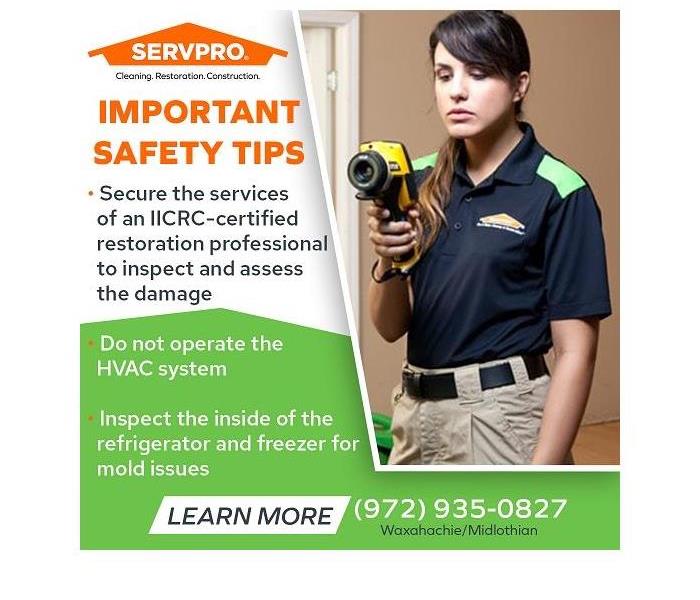What to Do When Appliances Have Been Affected by a Water Damage Disaster
10/10/2022 (Permalink)
Blog Summary: SERVPRO of Waxahachie/Midlothian advises homeowners on how to deal with appliances suffering from water damage safely.
SERVPRO® of Waxahachie/Midlothian understands the headaches that water damage can cause. Water damage is not only disruptive and inconvenient, but it can also be dangerous when electrical appliances are involved. Most homes have multiple electrical devices in every room. When these devices are exposed to high levels of moisture or become submersed in water, the risk hazard of shock, electrocution, or fire is elevated.
Below are just a few of the electrical hazards in certain rooms of the home:
- Bathroom: hair dryer, radio, electric clippers, curling iron, fan, portable lamps, cosmetic mirrors
- Kitchen: coffeemakers, blender, food processor, juicer, air fryer, toaster, microwave oven, television
- Laundry room: iron, washer, dryer, floor fan, vacuum cleaner, and freezer
- Home office: computers, monitors, laptop, printers, paper shredder, electric pencil sharpener, fans, recharging station for electronics
How to deal with water-damaged appliances
When entering the home, avoid using any appliances (electric or gas) without first taking necessary safety precautions. The homeowner’s first reaction after a water damage disaster or weather-related flooding may be to venture into the home and assess the extent of the damage. Avoid this impulse. The contents of the house may have shifted, damaging gas lines, electrical wiring, and outlets. The risk is very high. High water may have ripped gas-operated appliances (oven, water heater) from the supply lines. A rotten-egg smell is a strong indication that natural gas is leaking into the home. If a gas leak is detected, immediately evacuate the structure and call 911. Keep everyone a safe distance from the house until the danger is averted.
Moisture and water can quickly render appliances and the HVAC system useless and dangerous. In the case of electrical appliances, the severity of the situation depends on several factors:
- Extent of exposure
- Length of exposure
- Contamination levels from sewage or mold
Important safety tips to keep everyone safe
The safety steps listed below can help families and pets navigate a water damage disaster safely.
#1. Secure the services of an IICRC-certified restoration professional to inspect and assess the damage.
Contact a qualified, reputable property damage cleanup and restoration specialist to inspect and assess the situation. Make sure the company is competent to handle appliances and electronics that have been subjected to moisture and water. Wait for the team to arrive. SERVPRO of Waxahachie/Midlothian has the fastest response times in the industry. With water-damaged electronics and appliances, minutes make a difference.
The operation of an appliance such as a dishwasher, washing machine, or computer after a few hours of air-drying can destroy the appliance, shock anyone touching the device, or cause a fire. Never enter a home with standing water, especially if the structure still has power. If someone nearby is using a generator to power a home, the power lines could be “hot” with backflow from the generator. The appliance may appear to be thoroughly dried out, but internal components can trap moisture, hindering or preventing fast evaporation of the water and humidity. Testing the appliance can prove to be an “electrifying” experience. Do not operate an electrical appliance until a qualified technician has approved the device or appliance for use.
#2. Do not operate the HVAC system.
It is tempting to operate the HVAC system when humidity levels in the home are high, and the temperature is sweltering. HVAC components inside the house may be water-logged, and ductwork may be flooded or separated. After only a day or two, mold becomes a concern. Activation of the HVAC system can spread mold spores throughout the entire home in a matter of minutes. Once a certified HVAC technician has inspected and approved the system, it can be used to cool the house and lower humidity levels.
#3. Inspect the inside of the refrigerator and freezer for mold issues.
If the refrigerator continuously operates throughout the water damage event, water in the moisture in the insulation dries out slowly. The warm, moist environment is perfect for fast mold growth. Insulation in a refrigerator is located higher up in the unit than insulation in a chest freezer. If the water level was no more than an inch or so deep, insulation in the refrigerator and the freezer should be fine. The compressor and condenser are sealed and, therefore, resistant to water damage.
If the water dispenser and ice maker are hooked up to the waterline and the water has been offline, or under a water alert, it is advisable to change the water filter to the refrigerator. Throw out any ice in the bins for at least two cycles to ensure the ice is safe. Wash and sanitize the container, and flush the water dispenser for several minutes.
SERVPRO of Waxahachie/Midlothian has been serving the area since 2000. The damage restoration company is locally owned and backed by a nationwide system of qualified franchises. Being centrally located in Ellis County means technicians are within a thirty-minute drive or less of any location in the community. The team of water restoration experts specializes in residential, commercial, and large-scale disaster cleanup and restoration.
For more information about Red Oak, TX, water damage restoration, contact the office by phone at (972) 935-0827 or email at acarey@SERVPRO10932.com.



 24/7 Emergency Service
24/7 Emergency Service
